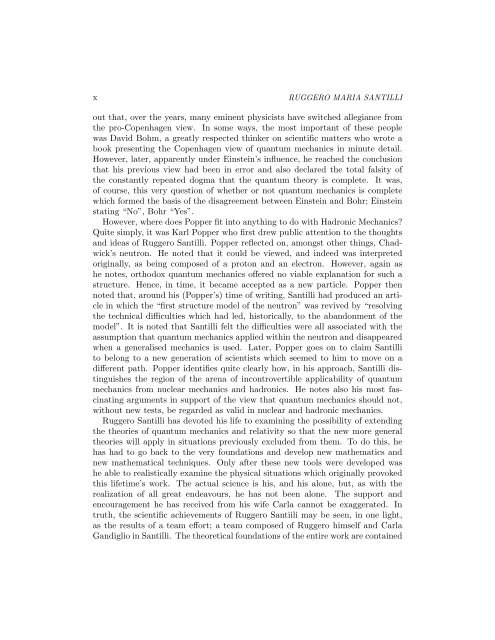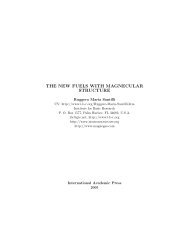hadronic mathematics, mechanics and chemistry - Institute for Basic ...
hadronic mathematics, mechanics and chemistry - Institute for Basic ...
hadronic mathematics, mechanics and chemistry - Institute for Basic ...
You also want an ePaper? Increase the reach of your titles
YUMPU automatically turns print PDFs into web optimized ePapers that Google loves.
x<br />
RUGGERO MARIA SANTILLI<br />
out that, over the years, many eminent physicists have switched allegiance from<br />
the pro-Copenhagen view. In some ways, the most important of these people<br />
was David Bohm, a greatly respected thinker on scientific matters who wrote a<br />
book presenting the Copenhagen view of quantum <strong>mechanics</strong> in minute detail.<br />
However, later, apparently under Einstein’s influence, he reached the conclusion<br />
that his previous view had been in error <strong>and</strong> also declared the total falsity of<br />
the constantly repeated dogma that the quantum theory is complete. It was,<br />
of course, this very question of whether or not quantum <strong>mechanics</strong> is complete<br />
which <strong>for</strong>med the basis of the disagreement between Einstein <strong>and</strong> Bohr; Einstein<br />
stating “No”, Bohr “Yes”.<br />
However, where does Popper fit into anything to do with Hadronic Mechanics?<br />
Quite simply, it was Karl Popper who first drew public attention to the thoughts<br />
<strong>and</strong> ideas of Ruggero Santilli. Popper reflected on, amongst other things, Chadwick’s<br />
neutron. He noted that it could be viewed, <strong>and</strong> indeed was interpreted<br />
originally, as being composed of a proton <strong>and</strong> an electron. However, again as<br />
he notes, orthodox quantum <strong>mechanics</strong> offered no viable explanation <strong>for</strong> such a<br />
structure. Hence, in time, it became accepted as a new particle. Popper then<br />
noted that, around his (Popper’s) time of writing, Santilli had produced an article<br />
in which the “first structure model of the neutron” was revived by “resolving<br />
the technical difficulties which had led, historically, to the ab<strong>and</strong>onment of the<br />
model”. It is noted that Santilli felt the difficulties were all associated with the<br />
assumption that quantum <strong>mechanics</strong> applied within the neutron <strong>and</strong> disappeared<br />
when a generalised <strong>mechanics</strong> is used. Later, Popper goes on to claim Santilli<br />
to belong to a new generation of scientists which seemed to him to move on a<br />
different path. Popper identifies quite clearly how, in his approach, Santilli distinguishes<br />
the region of the arena of incontrovertible applicability of quantum<br />
<strong>mechanics</strong> from nuclear <strong>mechanics</strong> <strong>and</strong> <strong>hadronic</strong>s. He notes also his most fascinating<br />
arguments in support of the view that quantum <strong>mechanics</strong> should not,<br />
without new tests, be regarded as valid in nuclear <strong>and</strong> <strong>hadronic</strong> <strong>mechanics</strong>.<br />
Ruggero Santilli has devoted his life to examining the possibility of extending<br />
the theories of quantum <strong>mechanics</strong> <strong>and</strong> relativity so that the new more general<br />
theories will apply in situations previously excluded from them. To do this, he<br />
has had to go back to the very foundations <strong>and</strong> develop new <strong>mathematics</strong> <strong>and</strong><br />
new mathematical techniques. Only after these new tools were developed was<br />
he able to realistically examine the physical situations which originally provoked<br />
this lifetime’s work. The actual science is his, <strong>and</strong> his alone, but, as with the<br />
realization of all great endeavours, he has not been alone. The support <strong>and</strong><br />
encouragement he has received from his wife Carla cannot be exaggerated. In<br />
truth, the scientific achievements of Ruggero Santiili may be seen, in one light,<br />
as the results of a team ef<strong>for</strong>t; a team composed of Ruggero himself <strong>and</strong> Carla<br />
G<strong>and</strong>iglio in Santilli. The theoretical foundations of the entire work are contained














